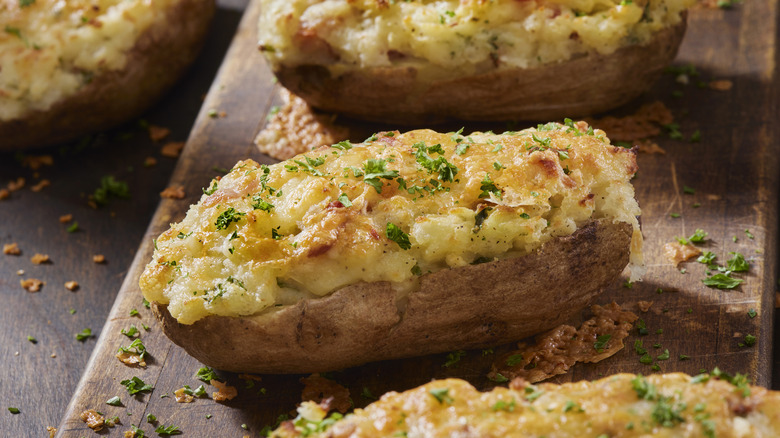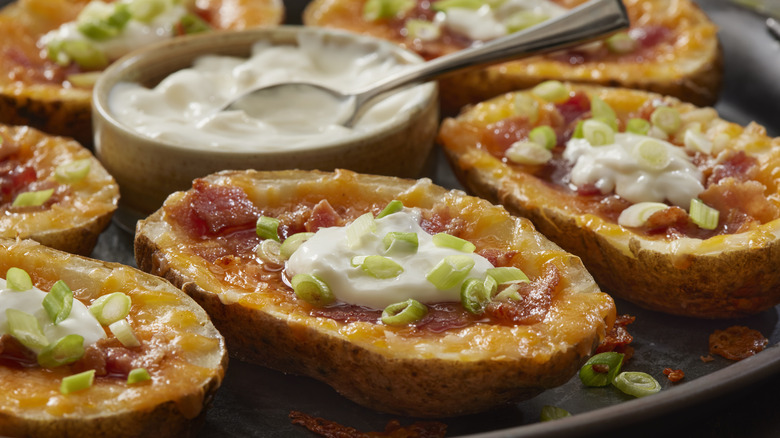Twice Baked Vs Potato Skins: Are They The Same Thing?
A potato, properly prepared, is a treat unmatched by any other starch. The highly versatile tuber can be cooked in almost infinite ways. However, the baked potato holds a special place in the realm of potato dishes. Even within this category there are several variations. This is where twice baked potatoes and potato skins come in. Though both preparation methods call for double cooking potatoes, they are not one and the same. The main difference between the two styles of spuds can be found in the filling.
Twice baked potatoes are, as you may have guessed, potatoes that are baked twice. Between the first and second bake, the fluffy, cooked potato flesh is scooped out and mashed into a creamy, cheesy filling before being spooned back into the potato skins. Finally, each spud is topped with a variety of ingredients to elevate an otherwise simple baked potato, such as bacon or chopped green onions, and baked again.
Like twice baked potatoes, potato skins also involve scooping the flesh out after the first bake. However, it isn't ever added back. Instead, the crispy potato skins remain hollow. The final dish is topped with cheese and filled with other ingredients, such as chopped bacon, sour cream, and chives. In practice, however, the topping possibilities are endless.
Twice as good when twice baked
So, what's the scoop on twice baked potatoes? The two-in-one tuber (half baked, half mashed) is no doubt a delicious treat. Unlike potato skins, however, twice baked potatoes are typically served as a part of an entrée, rather than as an appetizer. Popular since at least the 1980s, they're a dinnertime staple — and for good reason. Twice baked potatoes are filling, crispy, and deliciously fluffy. So, how does one go about making a twice baked potato?
First, you'll want to choose the right potato. Russet potatoes work best for both twice baked and potato skins, as they're large with thick, sturdy skins and a starchy interior. To prep your potatoes, rinse off the spuds and dry them with a cloth or paper towel. Then, poke holes in the sides of each potato with a fork, rub olive oil (or any cooking oil) on the skin, add salt, and bake in the oven until fork tender. Once your potatoes are done baking, you'll want to open them and scoop out the flesh. Then, mix the scooped out potato with your choice of ingredients to make a mash. Popular choices include sour cream, milk, butter, and cheese. Once the mash is made, you'll add it back into the skin and bake again. You can top your twice baked potato with bacon, cheese, or anything you'd like (even fried potato peels, which are also tasty on potato soup, if you're into that sort of thing).
Load up those potato skins
Now, let's put some skin in the game or, rather, on the plate. Unlike twice baked potatoes, potato skins remain hollow after all the starchy flesh is scooped out. But what they lack in filling, they make up for in flavor. The crispy appetizers were (supposedly) invented by TGI Friday's. However, two other restaurants — R.J. Grunts in Chicago and The Prime Rib in Washington, D.C. – also claim credit for inventing potato skins. Whoever invented the dish, potato skins probably appeared on menus in the 1960s, and really took off in popularity in the 1980s when they became standard pub fare.
The preparation of potato skins is similar to twice baked potatoes. Both dishes are prepped, baked, and scooped out in the same way. But here's where things change. Potato skins don't have the filling put back in as with twice baked potatoes. You also don't have to bake them again. Some cooks choose to fry their potato skins, giving them an extra crunchy texture. The potato skins are filled with toppings such as cheese, sour cream, bacon, and green onions. However, you can customize them to your liking. Pulled pork stuffed potato skins, for example, are an unconventional but delicious option, while broccoli and cheese adds a veggie into the mix. And hey, Martha Stewart likes to top baked potatoes with caviar, so why not add some to your skins? Really, the world is your oyster or, rather, your potato skin.


